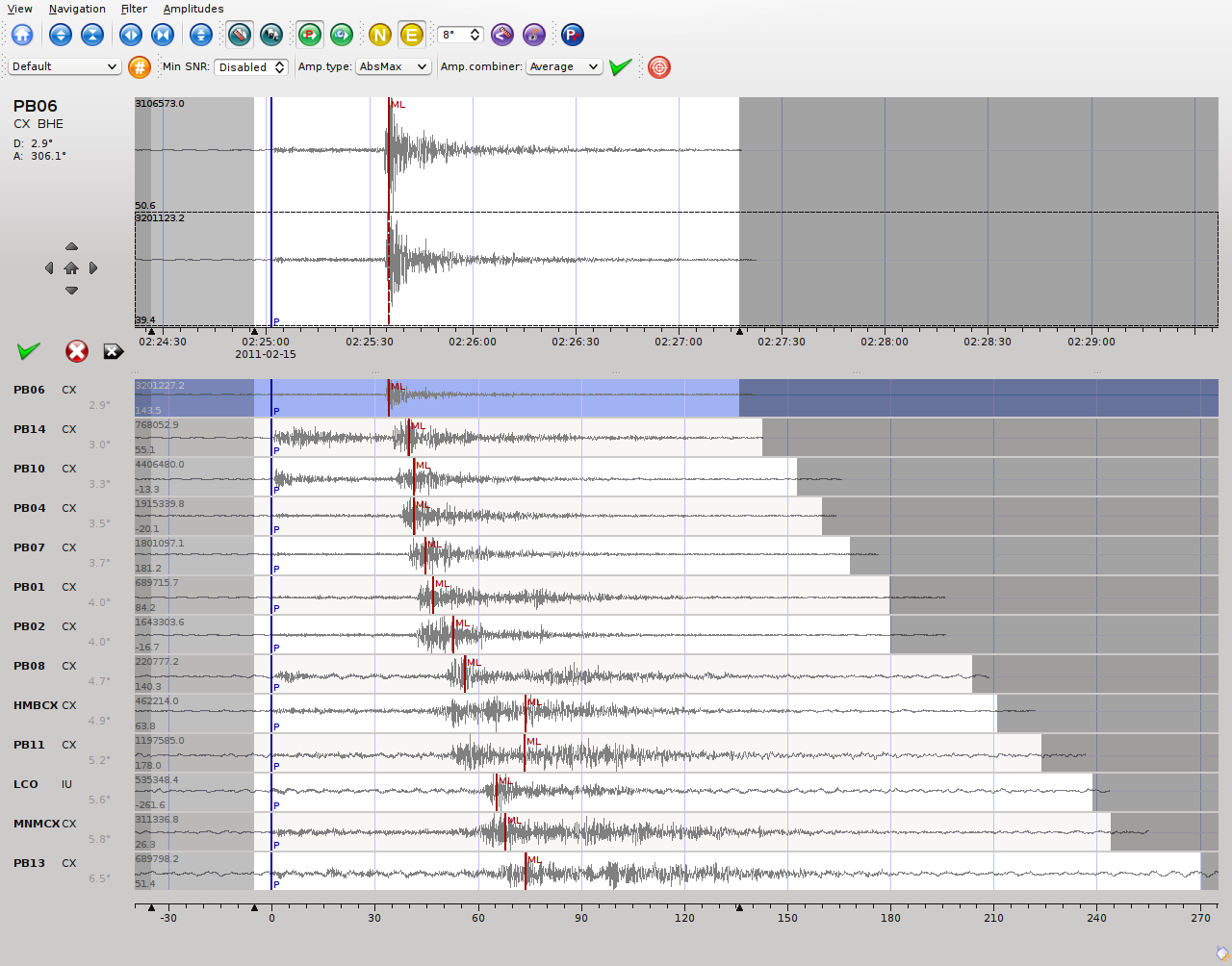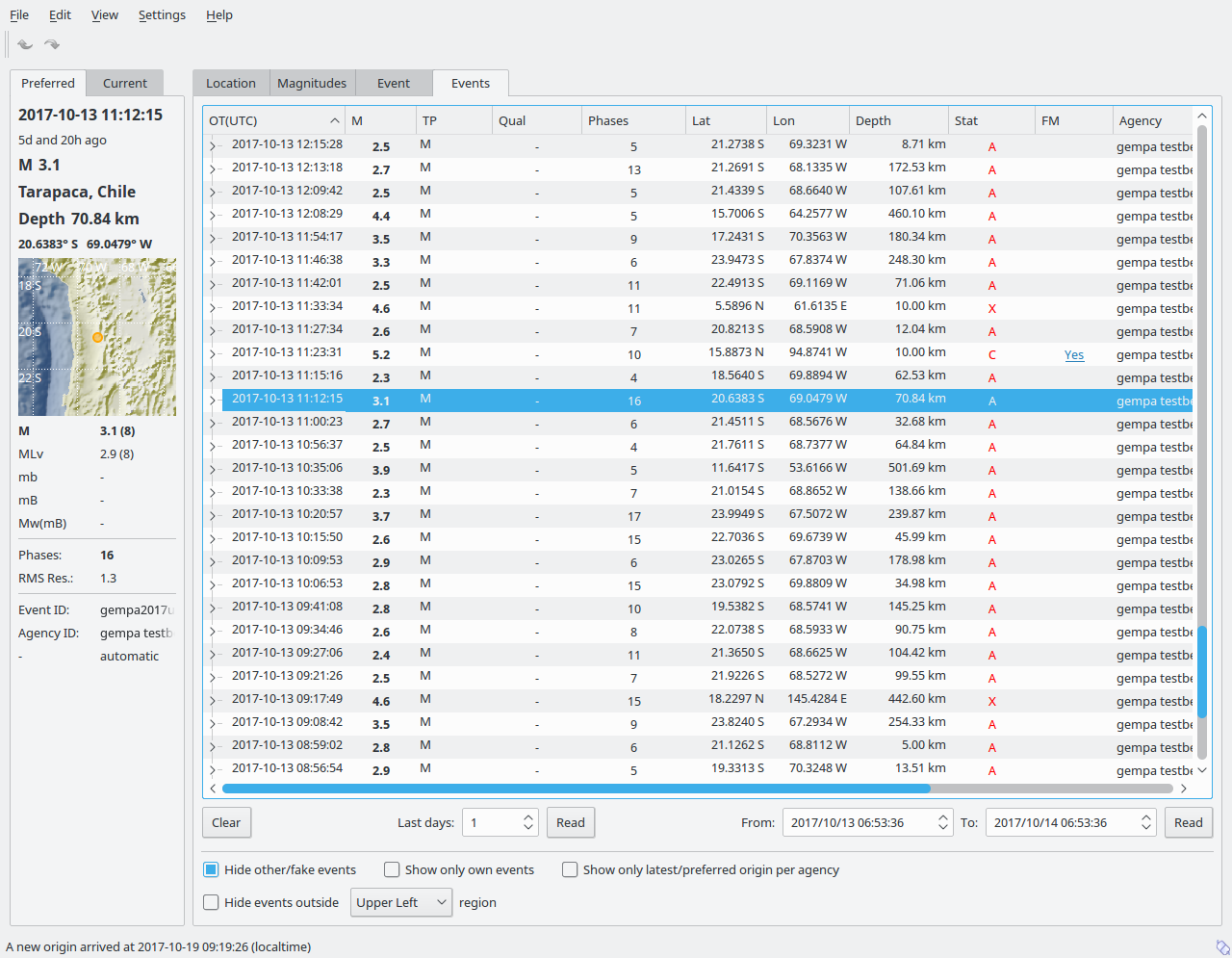scolv¶
Origin locator view
Description¶
scolv is the main interactive tool to revise or review the origin information such as picks, location, depth, time, magnitudes and event association. Therefore scolv is divided into five logical units (tabs):
scolv provides the whole functionality to review and revise earthquake parameters.
Units and digits¶
Local network users prefer the distance unit in kilometres while others prefer degrees. scolv (as any other GUI) can be configured to show either the one or the other.
# If true, show distances in km. Use degree otherwise.
scheme.unit.distanceInKM = true
Furthermore the precision of various values can be configured:
# Precision of depth values.
scheme.precision.depth = 0
# Precision of latitude/longitude values.
scheme.precision.location = 2
# Precision of magnitude values.
scheme.precision.magnitude = 2
# Precision of pick times (fractions of seconds).
scheme.precision.pickTime = 1
Summary widget¶
The summary widget contains two tabs: Preferred and Current. Preferred reflects the current official (database) state of the event while Current shows the current solution (location and magnitudes).
Plots¶
Some tabs in scolv are for plotting data (e.g. arrival residuals). Each plot is also interactive to select a subset of data or to zoom into a region.
A plot filter can be defined. Filtering means that arrivals that match the filter are not plotted. They are filtered out visually. To enable a filter click the link “not active” right below the plot tabs. A setup window pops up where the filter can be defined. Currently only a filter by azimuth around epicenter can be applied.
Select the center azimuth and the extent to either side. If OK is pressed all arrivals that fall outside the defined azimuthal area are hidden from the plot and the line below the tabs turns into “Filter is active”. Clicking on the link again and select the “None” filter will show all arrivals in the plot again.
The plot can also be configured to show dashed grid lines. The new default is on.
# Switch of grid lines by default
olv.drawGridLines = false
Location tab¶
The Location tab shows detailed information of the associated phases and the residuals from the chosen origin additional information about the hypocenter, time, station distribution, helps to find outlier.
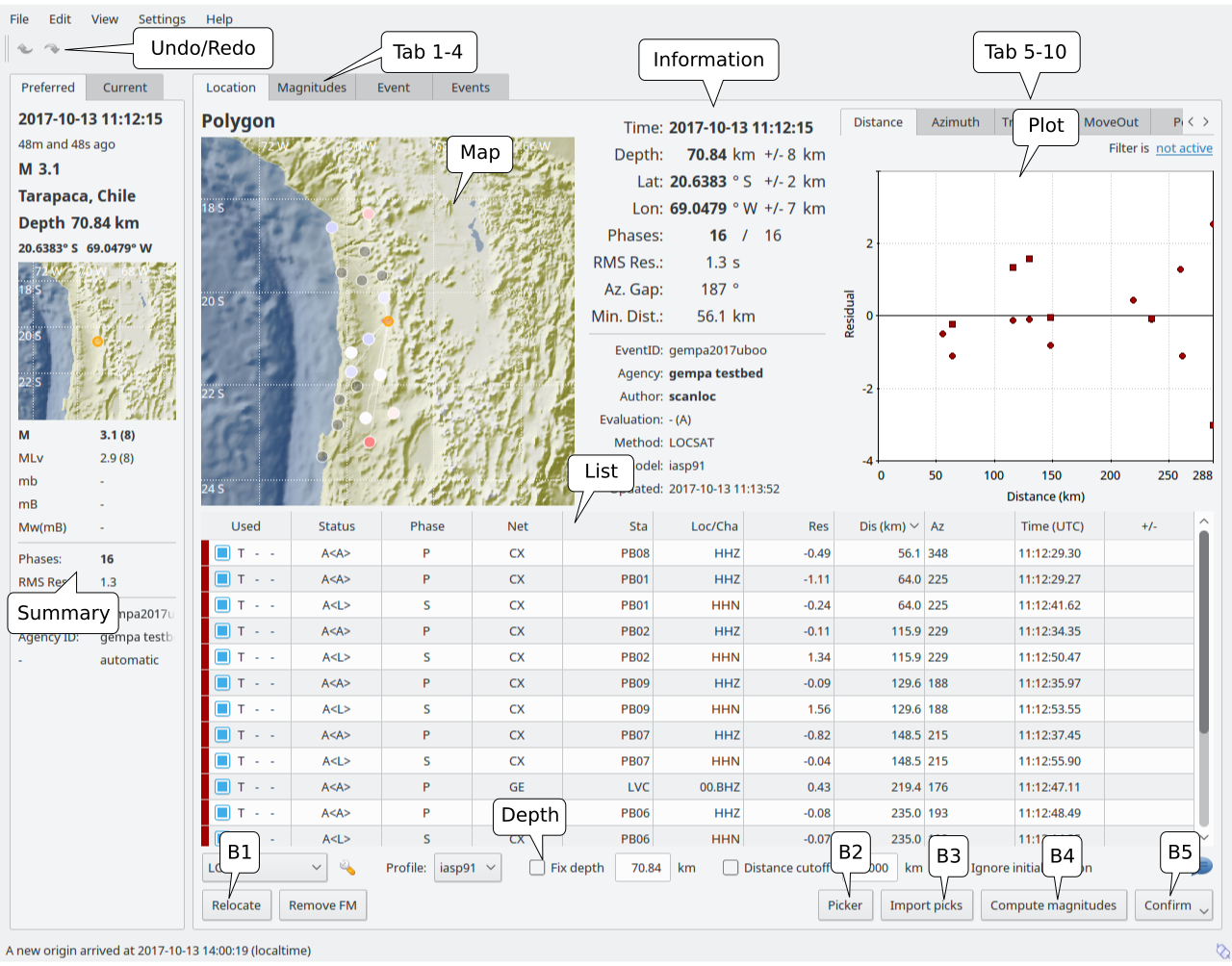
Location tab of scolv.
The default arrival residual plot is shown in the figure above. Additional 4 plots are available to analyze arrivals which can be shown by activating the corresponding tab.
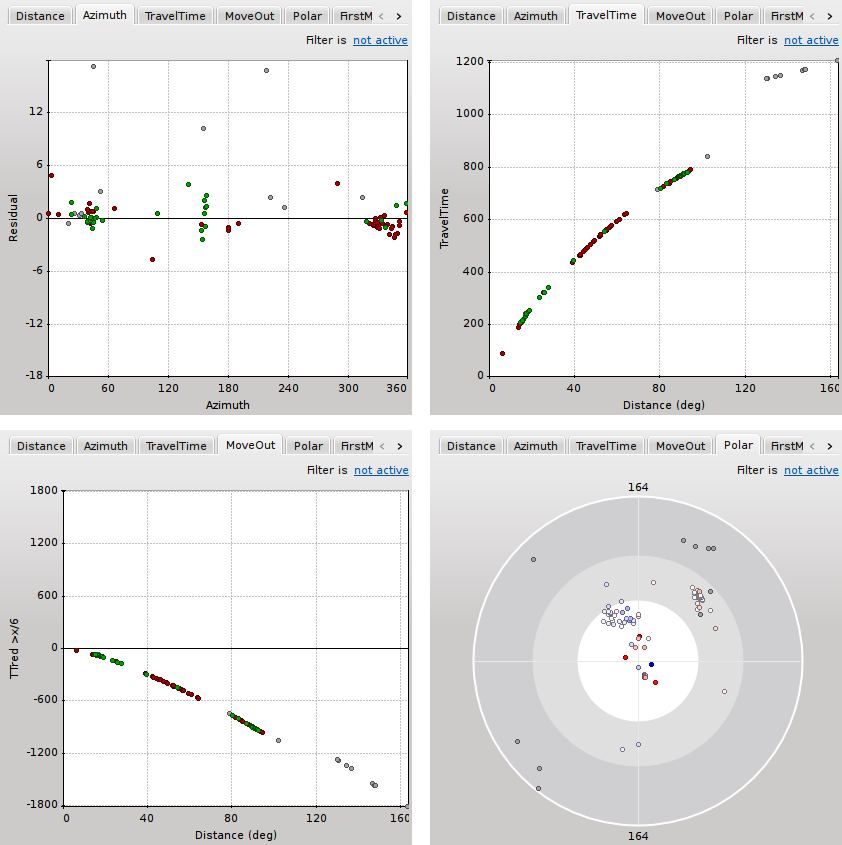
Additional arrival plots
The move out plot uses the reduced travel time with a default reduction velocity of 6km/s. This value is configurable, either in the configuration file or in the settings window.
# Reduction velocity used for move out plot
olv.Pvel = 6.0
When an event is relocated new magnitudes can be calculated by using the “Compute Magnitudes” button. The advantage of calculating the magnitudes before committing the new origin, is the possibility to check the resulting magnitudes before they are computed manually by scmag.
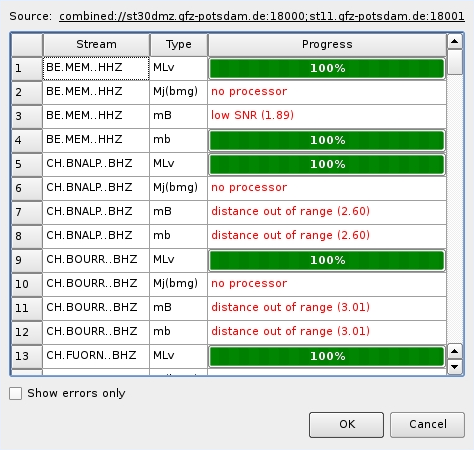
Compute magnitudes status window
A window will pop up giving the progress information of computation. The amplitudes are either fetched from database if the pick is unchanged and already in the system. For new manual picks, waveforms are requested to compute the amplitudes. The popup window contains information about the progress and possible errors. After closing this windows all available magnitudes are shown in the magnitudes tab (see next section).
Arrival table¶
The arrival table shows all arrivals of the current origin. The columns are sortable by clicking on the corresponding header item. Additional data columns can be shown or active columns can be hidden, either initially or interactively. Available column identifiers are:
- Used
- Status
- Phase
- Weight
- Method
- Polarity
- Net
- Sta
- Loc/Cha
- Res
- Dis
- Az
- Time
- +/-
- Created
- Latency
whereas only the columns printed bold are shown initially. The initial column
list can be changed in scolv.cfg:
olv.arrivalTable.visibleColumns = Used, Status, Weight, Phase, Net, Sta,\
Loc/Cha, Res, Dis, Az, Time, +/-
The user can also interactively select what columns are be visible or hidden from a context menu which pops up after a right click on the table header.
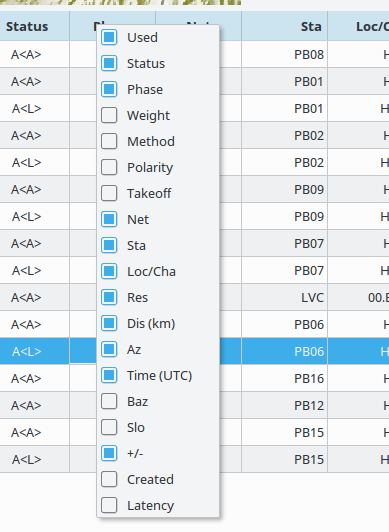
The checkbox in the first column indicates if the arrival was used for locating the origin. The overall usage state of arrival contains three flags: arrival time used, backazimuth used and slowness used. If any of these flags is active then the overall usage state is active as well. The arrival table shows those flags indicated by T for pick time, S for horizontal slowness and B for backazimuth. A flag is rendered with a dash if the referred pick does not contain the corresponding feature. For example, if a pick does not carry a backazimuth measure then the backazimuth flag is disabled. It would not make sense to activate backazimuth usage without a corresponding measure.
In most cases, only the time flag, indicated by the capital T, will be active. The other two flags are rendered with dashes, meaning that they are inactive. Background: an arrival refers to a pick which can hold several features. The basic feature a pick must hold is the pick time. Some modules such as for array processing might compute additional pick features. Such features can be the backazimuth and the horizontal slowness. Locators like LocSAT were developed to use those features to increase the precision of a location. Special applictions are locations based borehole networks with poor azimuthal coverage or locations with very few stations.
There may be cases where a backazimuth measure of a pick should not be used by the locator. In contrast, if a backazimuth is available but the timing is bad, disabling the use of the pick time but including the backazimuth may be advantageous. For that a simple weight value is not enough. With a weight one cannot separate whether or not to use a particular feature. So the arrival does not only refer to a pick but holds flags indicating which features of that pick should be used for locating.

Single or multiple rows can be selected in the table. The selection of multiple rows works either with Ctrl+LeftMouse (add single row) or Shift+LeftMouse (range selection).
When pressing the right mouse button on a selected row a context menu pops up. If an unselected row is used, the current selection will be reset and only the row below the mouse is selected.
The context menu allows to: * select arrivals based on a certain criterion * activate/deactivate selected pick features * delete selected arrivals * rename phases of selected arrivals
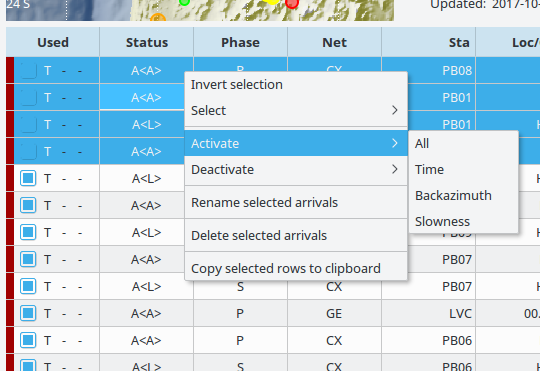
If arrivals are deleted, they are removed physically from this solution in contrast to deactivate an arrival where only the used flags are set to zero.
Waveform review (Picker)¶
The Picker button opens the interactive waveform picker window. It allows to pick additional phases, to confirm picks, to add additional pick information such as polarity and uncertainty, to rotate traces and much more.
It is divided into two parts, the zoom trace and the trace list. The zoom trace shows a sub area of the active trace in the list.
Initially the picker shows only the vertical channels for each station that have been associated with the current location. It can be configured to show all three components.
Initially the picker allows to pick the following phases:
- P
- Pn
- Pg
- pP
- S
- Sg
This list can be customized and phases can be grouped to reflect e.g. regional and teleseismic profiles. An example configuration looks like this:
# Define two phase groups: regional and teleseismic
picker.phases.groups = regional, teleseismic
# Define all phases of group "regional"
picker.phases.groups.regional = Pn, P, Pg, PmP, P1, Sg, S, Sn, SmS
# Define all phases of group "teleseismic"
picker.phases.groups.teleseismic = pP, PKP, PKP
# Define a list of favourite phases for quick access
picker.phases.favourites = Pn, P, Pg, PmP, P1, Pg, Sg, S, Sn, SmS
The list of favourites is used to assign shortcuts to. 1 is assigned to the first phase, 2 to the second and so on.
Note
Shortcuts are assigned only to the first 9 favourite phases. All other defined phases can be activated from the Picking menu.

Pick phase selection menu
To set the uncertainty of a pick a list of predefined uncertainties can be defined. Additionally uncertainties can be defined freely whereas choosing among a predefined set of uncertainties is a lot faster.
If the mouse hovers a pick a dashed rectangle is drawn around this pick. Then the pick is active and the right mouse button can be pressed to open the context menu where the polarity and uncertainty can be defined. The following screen shot shows the available uncertainties.
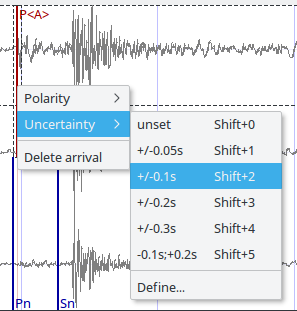
Pick context menu
They can be configured in scolv.cfg with:
# Define available pick uncertainty profiles. Single values
# are symmetric uncertainties whereas tuples are asymmetric
# uncertainties: (left,right). Uncertainty values are given
# in seconds.
# Define an uncertainty profile for local events
picker.uncertainties.profile.local = 0.05, 0.1, 0.2, 0.3, "(0.1,0.2)"
# Define an uncertainty profile for teleseismic events
picker.uncertainties.profile.teleseismic = 0.5, 1, 2, 3, "(1,2)"
# Define the list of uncertainty sets that are active in scolv.
# This first set in the list is used by default. The other sets
# can be activated in the settings dialog (scolv: F3)
picker.uncertainties.preferred = local, teleseismic
If an uncertainty is selected the active pick is copied into a manual pick and the uncertainty is displayed as semi transparent bar to the left and to the right of the pick. The width of the bar corresponds to the uncertainty in seconds.
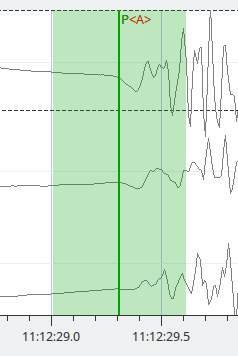
Furthermore the pick polarity can be defined.
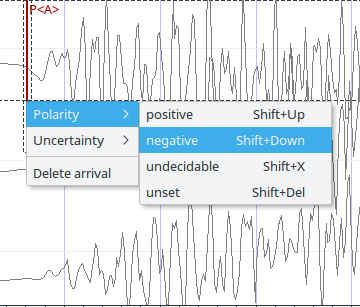
Either positive, negative, undecidable or unset. If set it is displayed as an arrow. Undecidable is displayed as a cross (X).

To rotate the waveform components into ZNE or ZRT system a new drop down list was added in the toolbar. Selecting either ZNE or ZRT implies that all missing components are requested.

When waveforms are requested the corresponding widget background is changed according to the current state:
- yellow: waveforms requested but not yet received
- red: acquisition finished and data is not available
- green: waveforms received and acquisition still in progress
If a trace displays all three components and amplitudes are scaled up, they are not clipped to their window area. The clipping behaviour can be toggled by either pressing C or in the menu .
The difference is shown in the following two images:
Commit a solution¶
Committing a solution means to send the location (including optional magnitudes) to the processing system and let it decide what origin becomes preferred.
To optimize the workflow
- select an event
- review solution
- commit solution
- change to event tab
- set this solution preferred
- set event type
- change to events tab
- goto 1.
to
- select an event
- review solution
- commit solution
- change to events tab
- goto 1.
an additional commit mode was added which allows to set certain options along with the location and its magnitudes.
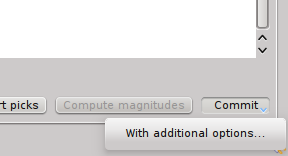
After pressing and holding the Commit button down for a little while, a menu pops up which allows to select With additional options. Selecting this entry brings up another window where the different options can be set.

It allows to fix the origin to be committed as preferred origin and to set the event type in one go. If Return to event list after commit is ticked the event list is activated after pressing OK to select another event quickly.
- Earthquake name
- Contains the event description earthquake name. If this field is empty the description will be removed from the event otherwise it will be added.
- Comment
- contains an optional event comment added as comment with ID Operator.
As a shortcut for committing with additional options,
custom commit buttons can be added by
configuration: Add, enable and configure a custom commit profile in
olv.customCommits.
With custom commit buttons origin and event paramters can be set, e.g.:
- origin status
- fixing the origin
- event type
- event type certainty
- magnitude type of the preferred magnitude. The preferred magnitude can also be set in the magnitude tab.
- event comments
Magnitudes tab¶
The Magnitude tab shows all available magnitude information for the current origin. They can be recomputed after creating a new origin, e.g. by relocating.
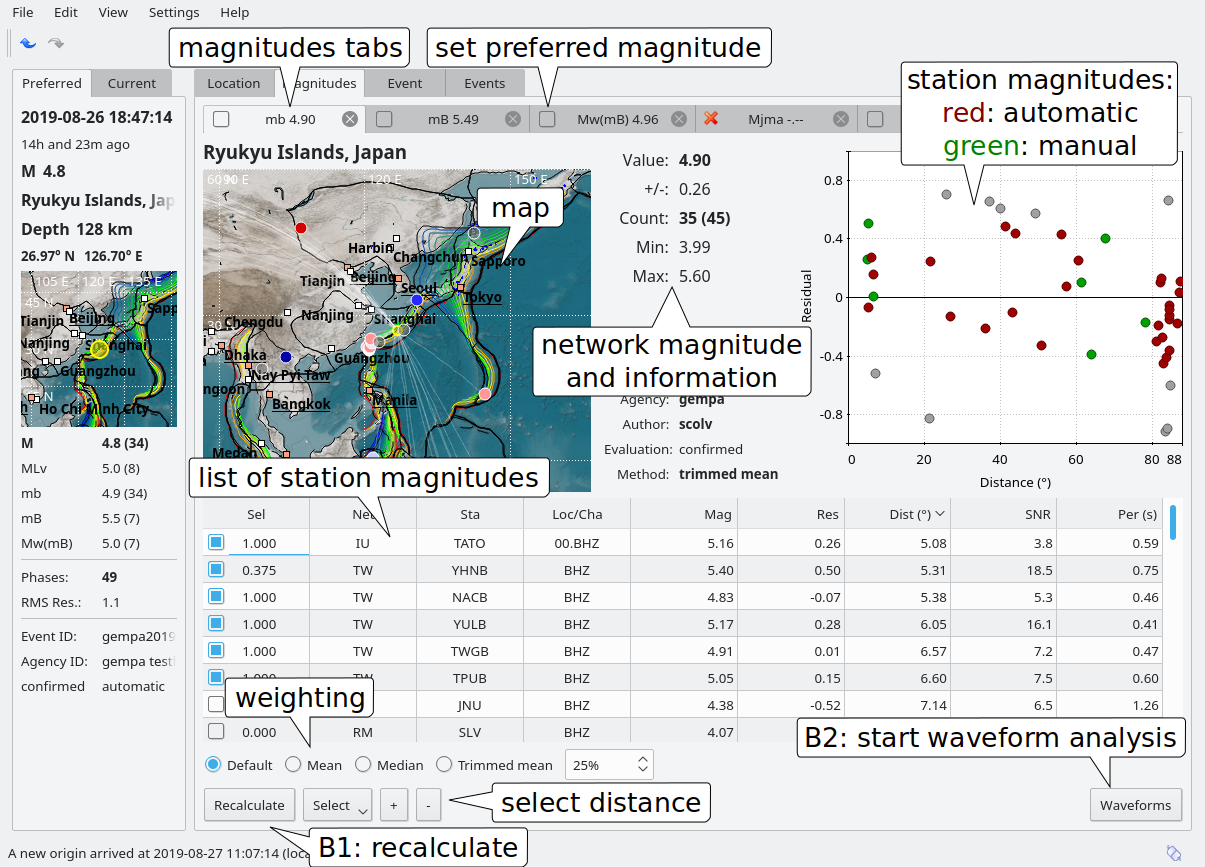
Magnitudes tab of scolv.
Station magnitudes¶
For each of the different magnitude types (e.g. mb, mB, MLv, Mw(mB)), the station magnitudes are shown in the magnitude residual plot and the table. The residual plot visualizes the difference between the station magnitude and the network magnitude for the different station distances. After relocation the magnitudes can be recalculated by the “Compute Magnitudes” button in the Location tab.
The station magnitudes can also be recalculated by interactive waveform analysis. Press the B2 button to start the interactive analysis.
Important
Magnitudes cannot be recalculated for origins loaded from database. To review magnitudes, create a new origin (relocate), recompute magnitudes and then change into this tab to open either the waveform review window or to just remove outliers.
Network magnitudes¶
Station magnitudes can be selected or unselected in the list and in the plot of station magnitudes for computating the corresponding network magntiude. The method and the margins to disregard outliers can be selected. Normally, the 25%-trimmed mean is calculated as network magnitude to stabilize the result against a few outliers.
Magnitudes that were not computed due to missing data or low signa-to-noise ratios have a cross button rendered in their tab headers and their value is nan (not a number). Furthermore was the status of the magnitude set to rejected. To manually review the waveforms and to fine tune the parameters, open the waveforms and add at least one station magnitude. Otherwise the rejected magnitude will be removed from the origin prio to committing it.
Summary magnitude¶
The summary magnitude typically is calculated from all network magnitudes by scmag and set as preferred magnitude type by scevent after committing or confirming an origin. The defaults can be changed by configuring scmag and scevent.
However, in combination with custom commit buttons, the network magnitude to be considered as the preferred can be set by hitting this configured button or interactively in the magnitude tab of scolv. Interactively check the box in the network magnitudes tab, then press the custom commit button. Setting the preferred magnitude interactively in the magnitude tab takes priority over the configuration of the custom commit button.
Waveform review¶
The magnitude review page also allows the review of waveforms. The button Waveforms brings up the amplitude waveform review page. The waveform review magnitude type is the same as the currently active tab.
The initial view loads all traces of all arrivals within the defined distance for that magnitude type. The zoom trace shows all components required for this particular amplitude type and the lower part shows all stations and only the currently active component. All traces are aligned on trigger time (blue P marker). If a station has got an amplitude it shows up as a red (automatic determined amplitude) or green (manually determined amplitude) marker. This display is similar to the Picker.
The toolbar contains two lines of settings. The first line is similar to the Picker, the second line is amplitude picker specific.

Second toolbar line: filter selection, filter toggle, min SNR editor, amplitude measurement type selector, amplitude combiner selector, (re)calculate amplitudes, apply amplitudes.
A station trace is divided into three areas:
- dark gray: unused data
- light gray: data used for noise offset and noise amplitude
- white: data used for amplitude calculation
The example above shows nicely how different data time windows are used for amplitude determination depending on the distance. This depends on the amplitude type and its implementation.
Things that can be done:
- show raw data
- change processing settings
- adjust processing areas (noise, signal) for a single trace or all traces
- apply a secondary filter (e.g. to remove noise or low frequencies)
- pick amplitudes within a user definable time window
- add unpicked/unassociated stations that are within a certain distance
- remove bad stations
Show raw data¶
By default the processed waveforms are displayed. To look at the raw waveforms change the filter drop down box to Raw.
Processing settings¶
A basic amplitude processor uses two basic settings: Minimum signal/noise ratio (SNR) and data time windows. The default minimum SNR is defined by the implementation of the amplitude algorithm. This default SNR is shown in the toolbar right from Min SNR:. In some situations an operator might want to increase or decrease the minimum SNR for some reason. This can be done by modifying the value in the corresponding spin box.
In the time scale of the zoom widget and the overview three black triangles are visible. Those triangles can be used to adjust the data time windows of either the zoom trace (upper part) or all traces (lower part) by dragging the handle with the left mouse button.
Some amplitude processors allow the modification of the type of amplitude measurement (e.g. absolute maximum or peak-to-peak) and/or the amplitude combiner procedure. This procedure is mostly used when a final amplitude from two components is computed, e.g. ML on the horizontals. The combiner procedure defines how the amplitudes of each horizontal are combined to a single amplitude, e.g. by taking the maximum of both or the average.
If the amplitude processor allows any of these options the corresponding drop down boxes are enabled in the toolbar and can be used to change the defaults.
Note
Amplitudes are not recalculated if any changes to the settings are made. Recalculation has to be activated manually (see below).
Secondary filters¶
Another option is to filter the data additionally to the internal filter of the amplitude processor. Be warned that wrongly applied filters screw up the results. The available filters can be defined in the settings dialog of scolv or in the configuration file similar to the manual picker filters:
# Define a list of available filters for amplitude picking in :confval:`amplitude.filters`.
# The format is "name1;filter-definition1", "name2;filter-definition2"
amplitudePicker.filters = "4 pole HP @2s;BW_HP(4,0.5)"
The new filter selection is applied immediately to the waveforms while the amplitudes are not recalculated (see next section).
Calculate amplitudes¶
To calculate the amplitudes of all traces with the current settings press the green check in the toolbar. It will process all traces and recalculate the amplitudes within the shown time windows. If an error occurs it will show up as a small message box in the station trace itself. If a new amplitude is available its state is set to manual and the marker is updated to reflect the new position of the amplitude. If the mouse hovers an amplitude marker a tooltip pops up after a certain amount of time and shows information about the amplitude.

Pick amplitudes¶
In addition to the default picking of all stations it is also possible to define the time window of the amplitude of a station manually. To do so, activate picking by pressing 1 or in the main menu: .
There are two modes of picking:
- create a time window by pressing with left mouse button at the start time and releasing at the end time, or
- double click at a time and use a time window of [t-0.5sec;t+0.5sec]
Add stations in range¶
Unpicked or unassociated stations can be added the same way as in the manual picker. The new stations will not have an amplitude and need either manual picking or global amplitude recalculation.
Remove bad stations¶
Stations can be disabled by either double clicking on the trace label in the overview or by deactivating an amplitude similar to deactivating a pick.
Confirm the amplitudes¶
The red button in the toolbar confirms all amplitudes and transfers them to the magnitude review page. Only activated amplitudes are transferred. Disabled stations or disabled amplitudes are ignored. At this stage all magnitudes are calculated and the network magnitude is calculated according to the available settings: Mean, Median or Trimmed mean.
Event tab¶
The Event tab gives all information of associated origins and magnitude of the actual event. Here the selection of the preferred origin and preferred magnitude can be influenced independent from scevent. The messaging between scevent and scolv about the selected origins and magnitudes can be viewed in a window that has to be opened by pulling the left side frame to the right.
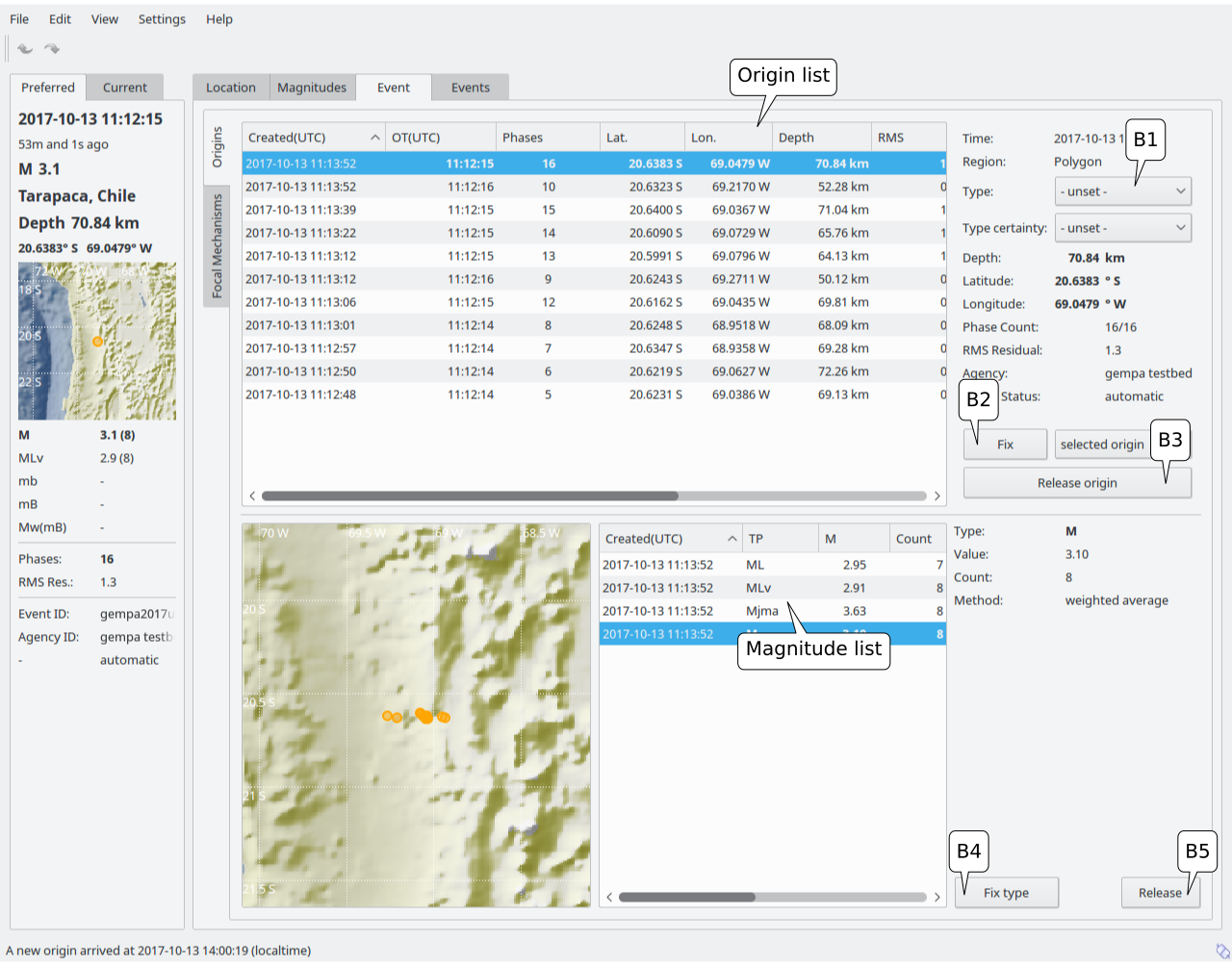
Event tab of scolv.
The map (lower left part) shows all associated origins while the currently selected origin (Origin list) is drawn filled.
Events tab¶
The Events tab gives an overview of the events in a defined time span. Information about origin time, preferred (“best”) magnitude, preferred magnitude type, number of phases, epicenter and depth, origin status, region, agency and event/origin ID are similar to the event list in scesv. Additionally, all origins associated with one event are displayed an event item is expanded.
Note
The region name of an event is read from the database or received via the messaging bus. It is an integral part of the event description and set based on the data set available at the time of the event creation. The region name of the origins is not part of the origin description and resolved dynamically when the information is required. That can lead to confusion if the dataset of the computer where the event has been created and the local dataset differs. Therefor the region names resolved locally are rendered with italic font style.
The event list contains a checkbox Hide other/fake events. If checked all events with type not existing or other are hidden. If unchecked they are shown. It is possible to configure the event types used for this filter as well as the label text of the checkbox.
# Define the event types to be filtered
eventlist.filter.types.blacklist = "not existing", "other",\
"outside of network interest"
# Define the label of the button to filter the events
eventlist.filter.types.label = "Hide fake events"
# Define the default behaviour
eventlist.filter.types.enabled = true
Another option to filter events is by agencyID. The button Show only own events
will hide all events where the preferred origins agencyID is not the configured
agencyID of scolv. This is the default behaviour which can be customized.
# Set the preferred agencyIDs to GFZ and EMSC
eventlist.filter.agencies.whitelist = GFZ, EMSC
# Set type to 'origins' which means that an event will pass the filter if
# at least one origin is from a preferred agency defined with the whitelist
# above. The default type is 'events' which checks only the events preferred
# origin.
eventlist.filter.agencies.type = origins
eventlist.filter.agencies.label = "Show only my preferred events"
# Enable this filter initially. If this option is not used the filter
# is disabled by default.
eventlist.filter.agencies.enabled = true
As with the arrival table the shown columns of the list are also configurable. The available identifiers are:
- OT(GMT)
- Type
- M
- TP
- Phases
- Lat
- Lon
- Depth
- Stat
- Agency
- Author
- Region
- ID
The bold identifiers are visible initially. This list can also be customized with
# Remove Type and Author from column list that is initially active
eventlist.visibleColumns = OT(GMT), M, TP, Phases, Lat, Lon,\
Depth, Stat, Agency, Region, ID
To show or hide columns interactively click with the right mouse button on the table header and check or uncheck the corresponding column.
Custom quantities¶
Since the internal data model is limited, scolv allows addition of custom quantities derived from the origin objects to the information panel, to the origin list of Event tab and to the Event list. This can help to evaluate origins in a better way.
Two source are supported, origin comments and custom scripts.
Origin comments¶
Currently only one comment can be added to the different panels.
To add a comment value to the information panel of the Location tab, the following configuration can be used:
# Define the comment id to be used
display.origin.comment.id = SED.quality
# Define the default display value if no comment is available
display.origin.comment.default = "-"
# Define the label text in the information panel for this value
display.origin.comment.label = Quality
To add a custom column to the origin list of the Event tab using a comment value, the following configuration can be used:
# Define the default value if no comment is present
eventedit.customColumn.default = "-"
# Define the comment id to be used
eventedit.customColumn.originCommentID = SED.quality
# Define the column header label
eventedit.customColumn = "Qual"
# Define the column position in the table
eventedit.customColumn.pos = 4
# Allows to map comment values (strings) to colors. In this case the
# comment will have A,B,C or D which is mapped to green, yellow, orange and
# red
eventedit.customColumn.colors = "A:00FF00","B:rgb(64,192,0)",\
"C:rgb(192,64,0)","D:FF0000"
To add a custom column to the event list of the Events tab using a comment value, the following configuration can be used:
# Define the default value if no comment is present
eventlist.customColumn.default = "-"
# Define the comment id to be used
eventlist.customColumn.originCommentID = "SED.quality"
# Define the column header label
eventlist.customColumn = "Qual"
# Define the column position in the table
eventlist.customColumn.pos = 5
# Allows to map comment values (strings) to colors. In this case the
# comment will have A,B,C or D which is mapped to green, yellow, orange and
# red
eventlist.customColumn.colors = "A:00FF00","B:rgb(64,192,0)",\
"C:rgb(192,64,0)","D:FF0000"
The last three examples are used to show the SED.quality comment value which is set by the NonLinLoc locator plugin.
External scripts¶
Another option to add derived origin parameters is to use external scripts. scolv will call those scripts and writes a binary serialized origin object to its standard input. scolv reads the script output and displays this value only if the return code of the script is 0.
An example script which just returns the standard error looks like this:
#!/usr/bin/env python
import seiscomp3.DataModel, seiscomp3.IO
def main():
ar = seiscomp3.IO.BinaryArchive()
# Open standard input
if not ar.open("-"):
# Hmmm, opening stdin failed
return 1
# Read the object
obj = ar.readObject()
ar.close()
# Try to cast obj to an origin
org = seiscomp3.DataModel.Origin.Cast(obj)
# No origin -> error
if not org:
return 1
# Try to print the standard error to stdout
try: print org.quality().standardError()
# Field not set, return error
except: return 1
return 0
if __name__ == "__main__":
sys.exit(main())
Important
The script must be executable. In Linux don’t forget to call
chmod +x /path/to/script
As many scripts as necessary to evaluate can be created.
Warning
Calling external scripts causes overhead and can take some time depending on the implementation of the script. scolv needs to access the database to fetch additional information which it does not need normally. The slower the database access, the longer it takes to display the results.
To add the output to the information panel of the Location tab, the following configuration can be used:
# Define the available add-ons to be used
display.origin.addons = qual1, qual2
# Configure each add-on
display.origin.addon.qual1.label = "Qual1"
display.origin.addon.qual1.script = "@CONFIGDIR@/scripts/scolv/qual1"
display.origin.addon.qual2.label = "Qual2"
display.origin.addon.qual2.script = "@CONFIGDIR@/scripts/scolv/qual2"
The same can be done for the origin list of the Event tab
eventedit.scripts.columns = qual1, qual2
eventedit.scripts.column.qual1.label = "Qual1"
eventedit.scripts.column.qual1.pos = 8
eventedit.scripts.column.qual1.script = "@CONFIGDIR@/scripts/scolv/qual1"
eventedit.scripts.column.qual2.label = "Qual2"
eventedit.scripts.column.qual2.pos = 9
eventedit.scripts.column.qual2.script = "@CONFIGDIR@/scripts/scolv/qual2"
and for the event list of the Events tab
eventlist.scripts.columns = qual1, qual2
eventlist.scripts.column.qual1.label = "Qual1"
eventlist.scripts.column.qual1.pos = 5
eventlist.scripts.column.qual1.script = "@CONFIGDIR@/scripts/scolv/qual1"
eventlist.scripts.column.qual2.label = "Qual2"
eventlist.scripts.column.qual2.pos = 6
eventlist.scripts.column.qual2.script = "@CONFIGDIR@/scripts/scolv/qual2"
Adding external scripts to the event list is the most expensive part. Whenever the event list is reloaded, it will start to run the scripts on all origins in the background. It can take a while until the complete list has been processed. A progress indicator is plotted in the middle of the event list while the background processes are running.
Settings¶
All settings of scolv can be adjusted in its configuration file. But to be able to change some settings on-the-fly, a settings windows is available which can be opened by pressing F3.
Global¶
This section contains settings for all the main tabs and all waveform windows.
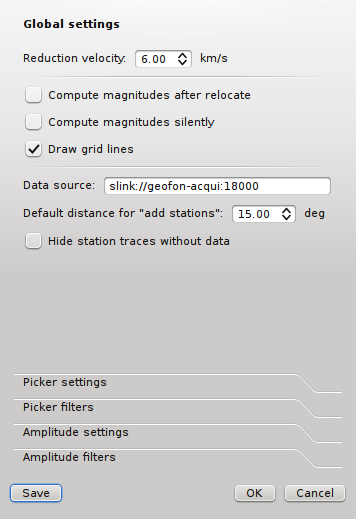
Global settings
- Reduction velocity
- Sets the reduction velocity used for plot MoveOut.
- Compute magnitudes after relocate
- Automatically computes magnitudes after each relocation. This has the same effect as pressing “Compute magnitudes” manually.
- Compute magnitudes silently
- Automatically closes the compute magnitudes dialog if the computation is finished and no error occurred.
- Draw grid lines
- Enables dashed grid lines in all plots.
- Data source
- Defines the waveform data source for both, pick review and amplitude review
- Default distance for “add station”
- The default value to add stations (traces) that have not been picked or associated is 15 degrees. A lower value can be defined, e.g. if mainly local events are analyzed.
- Hide station traces without data
- If new stations are added during pick review or amplitude review and if no data is available for some of those stations, they will be hidden and not shown. Once data arrives the trace becomes visible.
Picker¶
This section contains settings for the picker window.
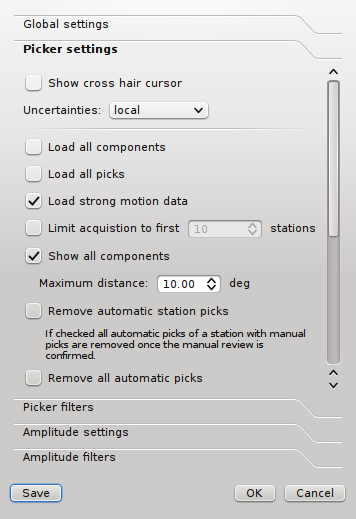
Waveform picker settings
- Show cross hair cursor
- Enables the cross hair cursor which shows the currently selected uncertainty ranges.
- Uncertainties
- Select the current uncertainty set to be used (
picker.uncertainties.preferred). - Remove automatic station picks
- If checked all automatic picks of a station with manual picks are removed once the manual review is confirmed.
- Remove all automatic picks
- If checked all automatic picks are removed once the manual review is confirmed.
Magnitude review¶
This section contains settings for the magnitude waveform review window.

Amplitude/magnitude review settings
- Waveform time window pre offset
- Sets an offset before the used amplitude time window that is used when collecting data.
- Waveform time window post offset
Sets an offset after the used amplitude time window that is used when collecting data.
The greater the offset the more the amplitude time window can be extended or shifted.
Hotkeys¶
The following table described the available key combinations and their triggered actions in scolv.
| Shortcut | Description |
|---|---|
| Mainwindow | |
| F2 | Setup connection dialog |
| F3 | Picker settings dialog |
| F8 | Display left event summary panel |
| F9 | Show ray paths and associated stations |
| F10 | Show event list |
| F11 | Toggle fullscreen |
| Ctrl+N | Create an unassociated artificial origin at the current map center |
| Ctrl+Z | Go back to last origin (if available) |
| Ctrl+Shift+Z | Go to next origin (if available) |
| Ctrl+PgUp | Load previous event from the event list |
| Ctrl+PgDown | Load next event from the event list |
| Mouse wheel | Zoom map in/out |
| Double click | Center map at the clicked position |
| Picker | |
| 1 .. 9 | Activate configured phase picking |
| Space | If phase picking is enabled, set pick |
| Esc | Leaving picking mode |
| F3 | Add station |
| F5 | Relocate |
| Y | Decrease row height of trace list |
| Shift+Y | Increase row height of trace list |
| S | Maximize visible amplitudes |
| Shift+S | Toggle spectrogram of selected trace |
| Ctrl+S | Show Fourier spectrum of selected trace |
| F | Toggle filter |
| Shift+F | Toggle filter but limits to the selected trace |
| Ctrl+F | Show spectrum of current trace |
| Z | Switch to Z-component |
| N | Switch to N-component |
| E | Switch to E-component |
| > | Increase time scale in trace overview |
| < | Decrease time scale in trace overview |
| Ctrl+N | Default trace view |
| Ctrl+T | Toggle display of theoretical arrivals |
| Ctrl+P | Toggle display of picks (not arrivals). If picks should be shown for the first, all picks within the time span of interest are loaded from database. The behaviour is the same as ticking the option “Load all picks”. |
| Ctrl+Up | Amplitude zoom in |
| Ctrl+Down | Amplitude zoom out |
| Ctrl+Right | Time zoom in |
| Ctrl+Left | Time zoom out |
| Ctrl+0 | Align by origin time |
| Ctrl+F1 | Align on P arrival |
| Ctrl+F2 | Align on S arrival |
| Ctrl+[1..9] | Align on 1st-9th favourite phase |
| Ctrl+Shift+[1..9] | Align on theoretical arrival of 1st-9th favourite phase |
| Ctrl+WheelUp | Amplitude zoom in |
| Ctrl+WheelDown | Amplitude zoom out |
| Shift+WheelUp | Time zoom in |
| Shift+WheelDown | Time zoom out |
| Ctrl+Shift+WheelUp | Time and amplitude zoom in |
| Ctrl+Shift+WheelDown | Time and amplitude zoom out |
| Left | Move trace view to left (fine) |
| Right | Move trace view to right (fine) |
| Shift+Left | Move trace view to left (rough) |
| Shift+Right | Move trace view to left (rough) |
| Up | Scroll up (through the traces) |
| Down | Scroll down (through the traces) |
| Alt+Right | Jump to next marker (picking mode) |
| Alt+Left | Jump to previous marker (picking mode) |
| Alt+D | Sort by distance |
| Alt+R | Sort by residual |
| T | Temporarily toggle 3 component view in picking trace |
| W | Reset scale in picking trace |
Configuration¶
etc/defaults/global.cfgetc/defaults/scolv.cfgetc/global.cfgetc/scolv.cfg~/.seiscomp3/global.cfg~/.seiscomp3/scolv.cfgscolv inherits global options.
-
loadEventDB¶ Type: double
Unit: days
Number of days to preload if scolv is started. Default is
1.
-
magnitudes¶ Type: list:string
Configures the list of magnitude types to be calculated when recomputing magnitudes. This list can be altered interactivly so this reflects only the default unless computeMagnitudesSilently is set to true. Default is
MLv,mb,mB,Mwp.
-
visibleMagnitudes¶ Type: list:string
A list of magnitude types to be displayed in the summary widget (F8). Default is
M,MLv,mb,mB,Mw(mB).
Type: string
Label of button that triggers user defined script0.
Type: string
Label of button that triggers user defined script1.
-
scripts.export¶ Type: string
User defined script which enables a publish button in the summary panel on the left side of scolv (activated with F8).
-
scripts.script0¶ Type: string
Full path to the script executed when hitting the button labeled with button0.
-
scripts.script1¶ Type: string
Full path to the script executed when hitting the button labeled with button1.
-
scripts.export.silentTerminate¶ Type: string
If the publish button is clicked while another script is still running, a message box pops up with a warning that a script is still running and to option to terminate it. If this flag is true then it will be terminated automatically without user interaction and the warning message. Default is
false.
-
olv.defaultEventType¶ Type: string
Sets the default event type to be used when confirming a solution. If not set, the event type is not changed at all unless “with options” is used. The origin or its source must be associated with an event already.
-
olv.commonEventTypes¶ Type: list:string
A list of event types which are commonly set. This defines a priority list which will be displayed on top of the event type selection menu. Additionally the remaining (non-prioritized) types are displayed with less contrast. The order is preserved in the event editor as well as in the drop-down list of the “Commit with additional options” dialog.
-
olv.defaultMagnitudeAggregation¶ Type: string
Sets the default magnitude aggregation method. It can be either “mean”, “trimmed mean” or “median”. If not set the default behaviour is used which computes the mean if less than 4 stations are available, trimmed mean otherwise.
-
olv.computeMagnitudesAfterRelocate¶ Type: boolean
Automatically starts computation of magnitudes after relocating an origin. Default is
false.
-
olv.computeMagnitudesSilently¶ Type: boolean
Starts magnitude computation without user interaction if everything runs without errors. In case of errors a window pops up with the current state of processing. Default is
false.
-
olv.enableMagnitudeSelection¶ Type: boolean
If enabled a magnitude selection pop window will open in advance to compute magnitudes. The default selection reflects the configuration parameter “magnitudes”. Default is
true.
-
olv.Pvel¶ Type: double
Unit: km/s
The P reduction velocity used in the “move out” plot. Default is
6.0.
-
olv.drawMapLines¶ Type: boolean
Sets the drawing of lines in the map connecting the station with the event. Default is
true.
-
olv.drawGridLines¶ Type: boolean
Sets the drawing of grid lines in the plot. Default is
true.
-
olv.computeMissingTakeOffAngles¶ Type: boolean
If a locator does not populate the take off angle in its arrivals the first motion plot will not show picked polarities. This option defines whether to compute take off angles that are not present in the arrivals or not. Default is
true.
-
olv.defaultAddStationsDistance¶ Type: double
Unit: deg
The default value for adding unassociated stations in the picker. Default is
15.
-
olv.hideStationsWithoutData¶ Type: boolean
If enabled then all traces without data are hidden in the picker. Default is
false.
-
olv.hideDisabledStations¶ Type: boolean
If enabled then all traces of disabled stations are hidden if they are not picked. Default is
false.
-
olv.defaultDepth¶ Type: double
Unit: km
When creating an artificial origin this is the default depth used. Default is
10.
-
olv.artificialOriginAdvanced¶ Type: boolean
Adds advanced input parameters in artificial origin dialog. Default is
false.
-
olv.systemTray¶ Type: boolean
Adds an icon to the system tray and displays a message when a new event was received. Note that this feature requires libQt4 version 4.3 or higher. Default is
true.
-
olv.map.stations.unassociatedMaxDist¶ Type: double
Unit: deg
Maximum distance in degrees up to which also unassociated stations are shown in the map. The default value is 360 which will show all unassociated stations. Default is
360.
-
olv.map.event.defaultRadius¶ Type: double
Unit: deg
Default map radius in degrees if a new event is selected. A negative value restores the default behaviour. Default is
-1.
-
olv.arrivalTable.visibleColumns¶ Type: list:string
Defines the visible columns in the arrival table. Valid tokens are: Used, Status, Phase, Weight, Method, Polarity, Takeoff, Net, Sta, Loc/Cha, Timeres, Dis, Az, Time, +/-, Slo, Slores, Baz, Bazres, Created, Latency
-
olv.locator.interface¶ Type: string
The default locator interface to use. Default is
LOCSAT.
-
olv.locator.defaultProfile¶ Type: string
The default locator profile to use.
-
olv.locator.minimumDepth¶ Type: double
Unit: km
Minimum depth which is set if the locator used supports fixing the depth. If the depth is lower than this value the depth is then fixed to this configured value and the origin is relocated again.
-
olv.commit.forceEventAssociation¶ Type: boolean
Activates the button “Force association with event” when committing with additional options. This is just the default setting and can be changed manually when the dialog pops up. Default is
true.
-
olv.commit.fixOrigin¶ Type: boolean
Activates the button “Fix this origin as preferred solution” when committing with additional options. This is just the default setting and can be changed manually when the dialog pops up. Default is
true.
-
olv.commit.returnToEventList¶ Type: boolean
Whether to return to the event list after committing with additional options or not. Default is
true.
-
olv.commit.eventCommentOptions¶ Type: list:string
Turns the event comment input field into a drop down box allowing the user to select from a list a predefined comment values which may be changed if required.
Note
olv.customCommits.* Configure custom commit buttons which behave like shortcuts to “Commit with additional options”. Pressing a custom button does not open a popup window. Instead it reads the configured profile and applies the options to the event and origin. Each commit button can be coloured and labeled.
Note
olv.customCommits.$name.* $name is a placeholder for the name to be used.
-
olv.customCommits.$name.enable¶ Type: boolean
Enable this commit button. Default is
true.
-
olv.customCommits.$name.askForConfirmation¶ Type: boolean
Ask for confirmation by presenting the “commit with options” dialog with the options pre-populated from this configuration. Cancelling the dialog aborts the commit procedure. Default is
false.
-
olv.customCommits.$name.forceEventAssociation¶ Type: boolean
Associate a new origin to the currently active event or not. Default is
false.
-
olv.customCommits.$name.fixOrigin¶ Type: boolean
Fix the origin as preferred solution in the event it is associated to. Default is
false.
-
olv.customCommits.$name.eventType¶ Type: string
The event type to be set of the event associated with the committed origin. If unset, the type remains unchanged. Use quotes for event types with spaces, e.g. “not existing”.
-
olv.customCommits.$name.eventTypeCertainty¶ Type: string
The event type certainty to be set of the event associated with the committed origin. If unset, the type certainty remains unchanged.
-
olv.customCommits.$name.originStatus¶ Type: string
The status to be set of the origin being committed. If unset, the status remains unchanged. If empty, the origin status will be set to none.
-
olv.customCommits.$name.magnitudeType¶ Type: string
Sets the preferred magnitude type of the event. If unset, no changes will be requested. If empty, the currently fixed preferred magnitude type will be reset.
-
olv.customCommits.$name.eventName¶ Type: string
Optional event name which will be set. This option exists for completeness and does not make much sense to be applied on any event. Use quotes for event names with spaces, e.g. “Quarry XYZ”.
-
olv.customCommits.$name.eventComment¶ Type: string
Optional event comment which will be set. Use quotes for event comments with spaces, e.g. “Blast on Monday morning”.
-
olv.customCommits.$name.returnToEventList¶ Type: boolean
Return to the event list after committing or not. Default is
false.
-
olv.customCommits.$name.label¶ Type: string
The commit button label. Use quotes for labels with spaces, e.g. “Earthquake reported”. Default is
Commit+.
-
olv.customCommits.$name.color¶ Type: color
Optional primary color for the bulk commit button. Use hexadecimal values.
-
olv.customCommits.$name.colorText¶ Type: color
Optional text color for the bulk commit button. Use hexadecimal values.
-
olv.customCommits.$name.tooltip¶ Type: boolean
Add a summary of the actions to the button’s tooltip. Default is
false.
Note
picker.* Parameters controlling the phase picker window.
-
picker.showCrossHairCursor¶ Type: boolean
Activates a cross hair cursor showing the configured uncertainties when in picking mode. Default is
false.
-
picker.ignoreUnconfiguredStations¶ Type: boolean
If enabled the picker will not add stations that are not configured with a detecStream. Default is
false.
-
picker.loadAllComponents¶ Type: boolean
Loads all three components by default. If disabled then additional components are fetched when requested. Default is
true.
-
picker.loadAllPicks¶ Type: boolean
Loads all existing picks for the requested data time window. Default is
true.
-
picker.loadStrongMotion¶ Type: boolean
If enabled then acceleration data is loaded for co-located stations where picked on velocity data. Default is
false.
-
picker.showAllComponents¶ Type: boolean
If enabled then all three components are shown in the picker zoom trace. Default is
false.
-
picker.allComponentsMaximumDistance¶ Type: double
Unit: deg
Defines the distance limit for the showAllComponents flag. Default is
10.
-
picker.usePerStreamTimeWindows¶ Type: boolean
If enabled data is requested around the P pick for each stations. Otherwise origin time is used and the time window for all stations is the same. Default is
false.
-
picker.removeAutomaticPicksFromStationAfterManualReview¶ Type: boolean
After picking and pushing the solution back to scolv all automatic arrivals are removed from a station if a manual pick exists. Default is
false.
-
picker.removeAllAutomaticPicksAfterManualReview¶ Type: boolean
After picking and pushing the solution back to scolv all automatic arrivals are removed from all stations regardless if a manual pick exists or not. Default is
false.
-
picker.preOffset¶ Type: int
Unit: s
The data time span added to the left of either origin time or first arrival depending on the usePerStreamTimeWindows flag. Default is
60.
-
picker.postOffset¶ Type: int
Unit: s
The data time span added to the right of the requested time window. Default is
120.
-
picker.minimumTimeWindow¶ Type: int
Unit: s
Minimum data time window length. Default is
1800.
-
picker.alignmentPosition¶ Type: double
Unit: s
Defines the relative position of the alignment when traces are aligned at a phase. This value is bound to interval [0:1] where 0 is the left side and 1 is right side of the trace window. Default is
0.5.
-
picker.uncertainties¶ Type: list:string
Unit: s
Defines a list of predefined uncategorised uncertainties. The format of each list item is either a double value or a pair of double values for asymmetric uncertainties in format “(val1,val2)”. This parameter is only used if picker.uncertainties.preferred has not been defined.
-
picker.phases¶ Type: list:string
A list of phases that is available for picking in the Picking menu. This is a fallback for the more complex phase group definition “picker.phases.groups” which is not part of this module description. The phases are not accessible through hot keys as for “picker.phases.favorites”.
-
picker.showPhases¶ Type: list:string
Phases for which the theoretical arrival times are shown.
-
picker.filters¶ Type: list:string
List of filters available in the picker.
-
picker.velocityChannelCodes¶ Type: list:string
A list of channel codes to be used when searching for velocity channels. Usually this information is part of the meta data. In case it is not, this list is used.
-
picker.accelerationChannelCodes¶ Type: list:string
A list of channel codes to be used when searching for acceleration channels. Usually this information is part of the meta data. In case it is not, this list is used.
-
picker.uncertainties.preferred¶ Type: list:string
Unit: s
Defines a list of preferred pick uncertainty profiles.
Note
picker.uncertainties.profile.$name.*
$name is a placeholder for the name to be used and needs to be added to picker.uncertainties.preferred to become active.
picker.uncertainties.preferred = a,b
picker.uncertainties.profile.a = ...
picker.uncertainties.profile.b = ...
# c is not active because it has not been added
# to the list of picker.uncertainties.preferred
picker.uncertainties.profile.c = ...
-
picker.uncertainties.profile.$name¶ Type: list:string
Unit: s
Defines a list of pick uncertainties. The format of each list item is either a double value or a pair of double values for asymmetric uncertainties in format “(val1,val2)”.
-
picker.phases.favourites¶ Type: list:string
Phase types available for rapid picking by hot keys and in the Picking menu. Make sure, the locator can handle all phases. Separate phase types by comma.
Note
picker.integration.* Settings related to waveform integration which may be required if the desired waveform unit is changed and the sensor data must be integrated once or multiple times.
-
picker.integration.preFilter¶ Type: string
An optional pre-filter which is applied prior to the numerical integration to stabilize the result. This filter is applied for each integration step or just once depending on the parameter “applyOnce”. Multiple integrations are necessary if acceleration data should be converted to displacement.
-
picker.integration.applyOnce¶ Type: boolean
Whether to apply the pre-filter only prior the first integration step or prior to each step. Default is
true.
Note
amplitudePicker.* Parameters controlling the amplitude picker window for computing station magnitudes.
-
amplitudePicker.preOffset¶ Type: int
Unit: s
Time span in seconds to be added to the left of the used amplitude time window. Default is
300.
-
amplitudePicker.postOffset¶ Type: int
Unit: s
Time span in seconds to be added to the right of the used amplitude time window. Default is
300.
-
amplitudePicker.filters¶ Type: list:string
A list of filters used for the amplitude picker.
-
display.origin.addons¶ Type: list:string
-
display.origin.comment.id¶ Type: string
-
display.origin.comment.default¶ Type: string
-
display.origin.comment.label¶ Type: string
Note
display.origin.addon.$name.*
$name is a placeholder for the name to be used and needs to be added to display.origin.addons to become active.
display.origin.addons = a,b
display.origin.addon.a.value1 = ...
display.origin.addon.b.value1 = ...
# c is not active because it has not been added
# to the list of display.origin.addons
display.origin.addon.c.value1 = ...
-
display.origin.addon.$name.label¶ Type: string
Defines the label text of the information panel in the Location tab of the parameter evaluated by this addon.
-
display.origin.addon.$name.script¶ Type: string
Path to script to execute.
Command-line¶
Generic¶
-
-h,--help¶ show help message.
-
-V,--version¶ show version information
-
--config-filearg¶ Use alternative configuration file. When this option is used the loading of all stages is disabled. Only the given configuration file is parsed and used. To use another name for the configuration create a symbolic link of the application or copy it, eg scautopick -> scautopick2.
-
--pluginsarg¶ Load given plugins.
-
-D,--daemon¶ Run as daemon. This means the application will fork itself and doesn’t need to be started with &.
-
--auto-shutdownarg¶ Enable/disable self-shutdown because a master module shutdown. This only works when messaging is enabled and the master module sends a shutdown message (enabled with –start-stop-msg for the master module).
-
--shutdown-master-modulearg¶ Sets the name of the master-module used for auto-shutdown. This is the application name of the module actually started. If symlinks are used then it is the name of the symlinked application.
-
--shutdown-master-usernamearg¶ Sets the name of the master-username of the messaging used for auto-shutdown. If “shutdown-master-module” is given as well this parameter is ignored.
Verbosity¶
-
--verbosityarg¶ Verbosity level [0..4]. 0:quiet, 1:error, 2:warning, 3:info, 4:debug
-
-v,--v¶ Increase verbosity level (may be repeated, eg. -vv)
-
-q,--quiet¶ Quiet mode: no logging output
-
--componentarg¶ Limits the logging to a certain component. This option can be given more than once.
-
-s,--syslog¶ Use syslog logging back end. The output usually goes to /var/lib/messages.
-
-l,--lockfilearg¶ Path to lock file.
-
--consolearg¶ Send log output to stdout.
-
--debug¶ Debug mode: –verbosity=4 –console=1
-
--log-filearg¶ Use alternative log file.
Messaging¶
-
-u,--userarg¶ Overrides configuration parameter
connection.username.
-
-H,--hostarg¶ Overrides configuration parameter
connection.server.
-
-t,--timeoutarg¶ Overrides configuration parameter
connection.timeout.
-
-g,--primary-grouparg¶ Overrides configuration parameter
connection.primaryGroup.
-
-S,--subscribe-grouparg¶ A group to subscribe to. This option can be given more than once.
-
--encodingarg¶ Overrides configuration parameter
connection.encoding.
-
--start-stop-msgarg¶ Sets sending of a start- and a stop message.
Database¶
-
--db-driver-list¶ List all supported database drivers.
-
-d,--databasearg¶ The database connection string, format: service://user:pwd@host/database. “service” is the name of the database driver which can be queried with “–db-driver-list”.
-
--config-modulearg¶ The configmodule to use.
-
--inventory-dbarg¶ Load the inventory from the given database or file, format: [service://]location
-
--db-disable¶ Do not use the database at all
Records¶
-
--record-driver-list¶ List all supported record stream drivers
-
-I,--record-urlarg¶ The recordstream source URL, format: [service://]location[#type]. “service” is the name of the recordstream driver which can be queried with “–record-driver-list”. If “service” is not given “file://” is used.
-
--record-filearg¶ Specify a file as record source.
-
--record-typearg¶ Specify a type for the records being read.







